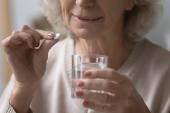Aspirin Use for Primary Prevention Declining in US: NHANES
After guideline changes, aspirin use dropped off overall, even for higher-risk patients in whom it might still be considered.

The use of aspirin for primary prevention has significantly declined in recent years following changes to clinical guidelines, with drop-offs seen in older adults as well as those with a low 10-year risk of atherosclerotic cardiovascular disease (ASCVD), new research shows.
While use declined in groups for whom aspirin is no longer recommended, there also were reductions among primary-prevention patients who might benefit from treatment, such as those with a high 10-year risk of ASCVD.
“There is really going to be a select population for whom that additional treatment [with aspirin] is the right one,” senior investigator Timothy Anderson, MD (University of Pittsburgh, PA), told TCTMD. While it’s likely “appropriate” that aspirin use for primary prevention declined overall, choosing to stop or start aspirin in certain patients depends on an individualized assessment, he said.
Anderson, who performed the study with Linnea Wilson, MPH (Beth Israel Deaconess Medical Center, Boston, MA), said that while aspirin might be the right choice for some high-risk patients, there are safer strategies for primary prevention, such as diet and exercise, as well as statins, which have a stronger protective effect with a better side effect profile.
Maciej Banach, MD, PhD (John Paul II Catholic University of Lublin, Poland), who wasn’t involved in the new analysis, said the study confirms trends also seen in Europe.
While aspirin use for secondary prevention is stable, its overall use diminished following the European Society of Cardiology 2021 guidelines that recommended against it for primary-prevention patients at low-to-intermediate risk of ASCVD. Even in the setting of diabetes, he said, aspirin is recommended only if the patient is at high ASCVD risk, although the vast majority of patients with diabetes would be considered to be at high risk.
“Based on the available data, including also the most recent open-label extension results of the ASPREE study presented at the [American Heart Association Scientific Sessions] in Chicago, these are quite reasonable recommendations,” Banach told TCTMD.
Changes to Guidelines
The new study, which was funded by the National Institutes of Health and published online January 22, 2025, in JAMA, focuses on five cycles of the National Health and Nutrition Examination Survey (NHANES) from 2011 to 2023, a period that captures guideline changes around aspirin’s use.
In 2019, the American College of Cardiology/American Heart Association (ACC/AHA) tightened up recommendations around aspirin, stating the drug should be used infrequently for primary prevention, following several trials that suggested limited benefit and likely some risk. Based on ASPREE, ARRIVE, and ASCEND, the guidelines now recommend against aspirin use for those 70 years and older and those with a higher risk of bleeding. For the 40- to 70-year-old patient, aspirin holds a weaker IIb recommendation, with experts saying it may be considered in those at high ASCVD risk who don’t have a risk for bleeding.
In 2022, the US Preventive Services Task Force also took a tougher stance on the use of aspirin for primary prevention, stating that people ages 60 or older who do not already have heart disease should not start taking it. For those ages 40 to 59 years, starting aspirin should be made on a patient-to-patient basis and only if their individual 10-year risk of CVD is 10% or higher, said the Task Force.
Anderson said that one of the concerns with the guideline changes, and the media communication around it, was that patients with an appropriate indication might stop taking it.
“It’s abundantly clear that there’s not a benefit from aspirin in folks with truly low atherosclerotic cardiovascular disease risk,” he said. “But for those folks with moderate or elevated risk, what exactly to do is a little bit unclear.”
For that reason, they wanted to look at trends in preventive aspirin use in patients with varying ASCVD risk. The NHANES study population included 18,294 people (mean age 57 years; 51.7% female) who responded affirmatively that they were taking aspirin “to prevent heart attacks, stroke, or cancer.” From 2011-2012 to 2021-2023, there was no change in the percentage of patients taking aspirin for secondary prevention. After the ACC/AHA guidelines were updated, there was a 6.3% reduction in aspirin use in primary-prevention patients, declining from 23.5% in 2017-2020 to 17.7% in 2021-2021 (P < 0.001).
Across subgroups, aspirin use among those older than 70 years declined from 46.1% in 2017-2020 to 34.4% in 2021-2023 (P < 0.001), an 11.7% decrease in use. In those with a 10-year risk of ASCVD of less than 10%, aspirin use declined from 16.5% to 10.8% during the same time period (P < 0.001). However, in those with an ASCVD risk 10% or greater, a group in whom aspirin may be considered, use declined from 33.6% to 27.8% (P = 0.04).
In the groups where aspirin is clearly not recommended—those older than 70 years and those with a low 10-year risk of ASCVD—the magnitude of aspirin’s decline varied in different subgroups.
For example, in African American and Asian patients, aspirin use declined by 0.2% and 0.7% between 2011-2020 and 2021-2023 but declined by 8.3% in White patients. Aspirin use dropped off the most in those with private insurance and those with routine healthcare—9.0% and 7.7% reductions, respectively, over the study period—whereas aspirin use increased 0.3% in patients without a routine healthcare location.
Anderson and Wilson both highlighted differences in aspirin’s decline across subgroups without an indication.
“One of the stronger [differences] is whether people have a regular source of care,” said Anderson. “It presumably reflects that if you have a regular source of care, then you go in for your annual visit or your regular checkup, whether the doctor initiates the conversation or whether you initiate the conversation, you have somebody to ask the question, ‘Should I be taking this?’”
Role for Aspirin in Select Patients
Banach, to TCTMD, pointed out that aspirin still has a selective role. When it comes to risk stratification, the emergence of novel risk factors and imaging have helped physicians optimize risk stratification to find patients in whom aspirin might be beneficial, he said.
Primary-prevention patients with elevated Lp(a) might be one group who could benefit from aspirin, he said. In one analysis of the Multi-Ethnic Study of Atherosclerosis, aspirin use was associated with a significant reduction in ASCVD risk in those with Lp(a) > 50 mg/dL without baseline disease. In a different analysis of patients in NHANES without ASCVD, aspirin use lowered the risk among those with high Lp(a) levels but not in those with low levels. Another primary-prevention subgroup that might benefit from aspirin includes patients with a coronary artery calcium (CAC) score > 100.
Recently, Banach and colleagues drafted recommendations on the use of combination therapy, including the use of aspirin in select patients at high or very ASCVD risk but without any hazards for bleeding.
“All [of this] has been just put in the expert opinion on the role of combination therapy based on statin and aspirin, in which, as a group of experts endorsed by the Polish Lipid Association, we recommended that in primary-prevention patients with additional risk factors, like elevated Lp(a) or CAC score >100, aspirin should be considered with a IIa class, instead of IIb, recommendations.”
Michael O’Riordan is the Managing Editor for TCTMD. He completed his undergraduate degrees at Queen’s University in Kingston, ON, and…
Read Full BioSources
Wilson LM, Anderson TS. Trends in preventive aspirin use by atherosclerotic cardiovascular risk. JAMA. 2025;Epub ahead of print.
Disclosures
- Anderson reports grants from the National Institute on Aging.
- Banach reports personal fees from Amgen, KRKA, Polpharma, Novartis, New Amsterdam, Sanofi-Aventis, Teva, Zentiva, Amgen, Daiichi Sankyo, Esperion, Novartis, Novo Nordisk, Polfarmex, and Sanofi-Aventis; and grants from Amgen, Daiichi Sankyo, Mylan/Viatris, Sanofi, and Valeant.





Comments